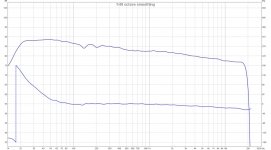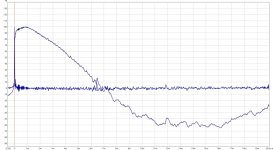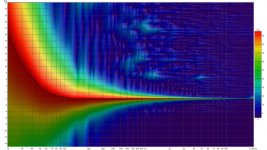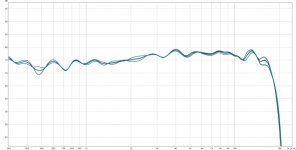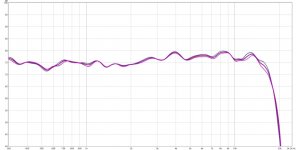If you want to take a guess at the driver, this picture should help:
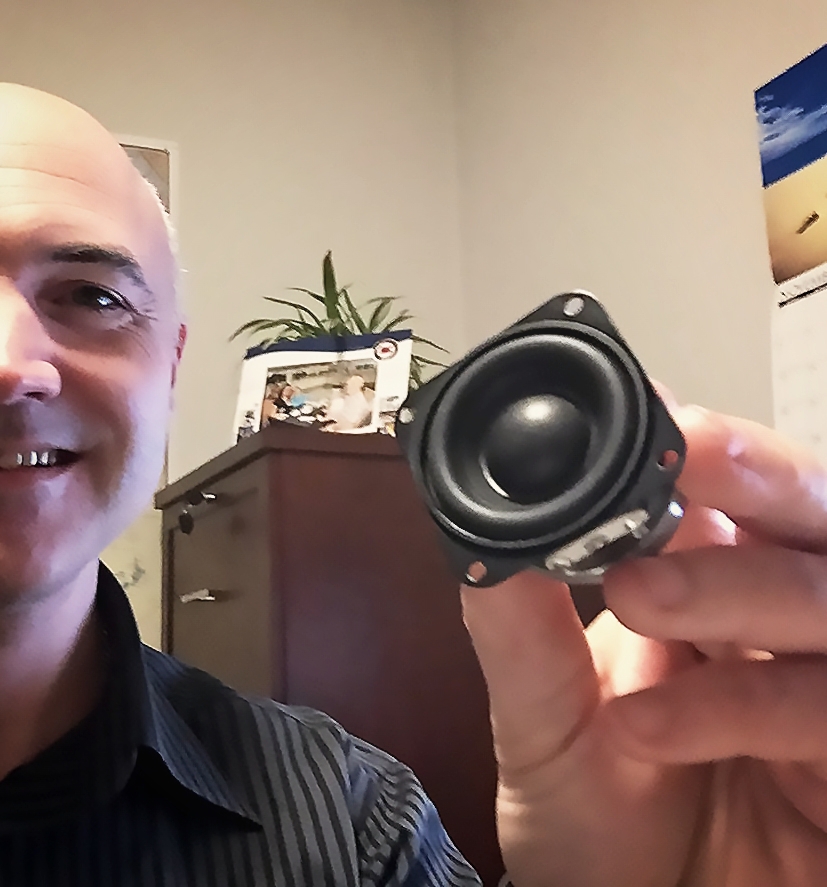
Taken from this page...
I can't imagine the "cheese on the right" being the actual enclosure shape. The R7 stories mention passive drivers on the back, that seems to be gone within the disclosure about the R+.

Taken from this page...
I can't imagine the "cheese on the right" being the actual enclosure shape. The R7 stories mention passive drivers on the back, that seems to be gone within the disclosure about the R+.
Yes, only the right channel. What you see there is the correction FIR data.
I've compared the measured RAW data with previous measurements. I think there's either something rattling along with the speakers (accessories that my girl likes to put in our house) or I need to re-tighten the front baffle . I'll soon find out.
. I'll soon find out.
There's a dip that wasn't there in earlier measurements.
On the accessories: there's a new metal wire frame basket right beside the array, usually filled with blankets. But it's close enough to be a suspect.
This dip starts around 6 cycles, which is odd. If it were the baffle, I imagine it would start to show up in the first few cycles as well.
I've compared the measured RAW data with previous measurements. I think there's either something rattling along with the speakers (accessories that my girl likes to put in our house) or I need to re-tighten the front baffle
There's a dip that wasn't there in earlier measurements.
On the accessories: there's a new metal wire frame basket right beside the array, usually filled with blankets. But it's close enough to be a suspect.
This dip starts around 6 cycles, which is odd. If it were the baffle, I imagine it would start to show up in the first few cycles as well.
Last edited:
FIR correction of one of the other measurements gives me this:

Much better, bit there's still a sign of a resonance on top. If I use this one as a correction it will still ring, only much less than the previous one.
Compared to the previous correction:

No EQ is going to fix that... If I could apply and save a 1/48 octave smoothed FIR file it would be gone.
Much better, bit there's still a sign of a resonance on top. If I use this one as a correction it will still ring, only much less than the previous one.
Compared to the previous correction:
No EQ is going to fix that... If I could apply and save a 1/48 octave smoothed FIR file it would be gone.
Attachments
Last edited:
Remember that this is the correction file we are looking at here.
This anomaly was the result of the measured file running trough the DRC-FIR software. But the reason is locked away somewhere in the measured frequency response.
If it is the speaker causing this, I can run an impedance check. If it is environment, I can remove the stuff close to the speaker. As it all happens within 1 ms, it has got to be very close in/to the path to the microphone.
It is amazing though, what you can hear, if you reduce the room influence far enough.
This anomaly was the result of the measured file running trough the DRC-FIR software. But the reason is locked away somewhere in the measured frequency response.
If it is the speaker causing this, I can run an impedance check. If it is environment, I can remove the stuff close to the speaker. As it all happens within 1 ms, it has got to be very close in/to the path to the microphone.
It is amazing though, what you can hear, if you reduce the room influence far enough.
...I must get a mic. Are any USB measuring mic's OK?
They okay although own experience is you get less interference measurements grass and better synchronize possibilities using hardware where I/O comes from same clock, that means there will be added cost for a mic preamp if soundcard doesn't offer that feature. As i see it if we talk lowcost Cross·Spectrum Labs - Sound | Vibration | Engineering have nice offer for analog EMM-6 or digital UMIK-1 that include dedicated calibration up to 25kHz if you pick the right package.
Is there a really cheap (2 usd?) driver to use for a concept try-out?
//
Probably there is, but as i see it problem is one will put a lot of work into build a complicated floor to ceiling system just to find its a very good concept and one wants more then, so why not use relative cheap TC9 from the start and get less exhausted : )
I only had some computer time available, so I re-did some steps with the FIR correction that had the problem at ~10k reduced.
Here's some predictions for the Stereo result:
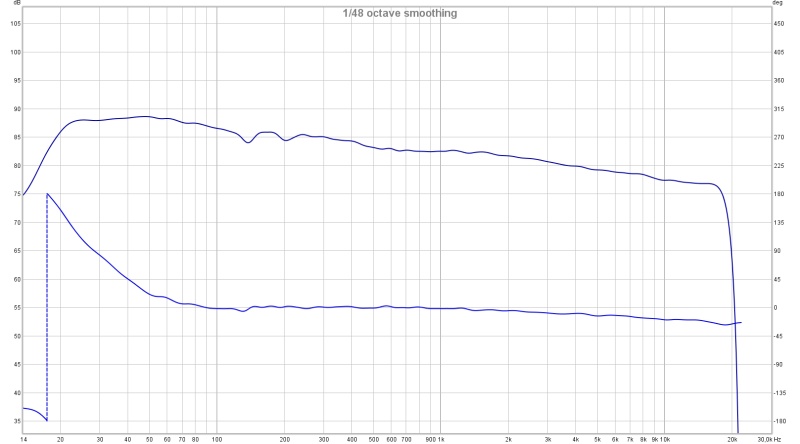
The predicted IR at the sweet spot:
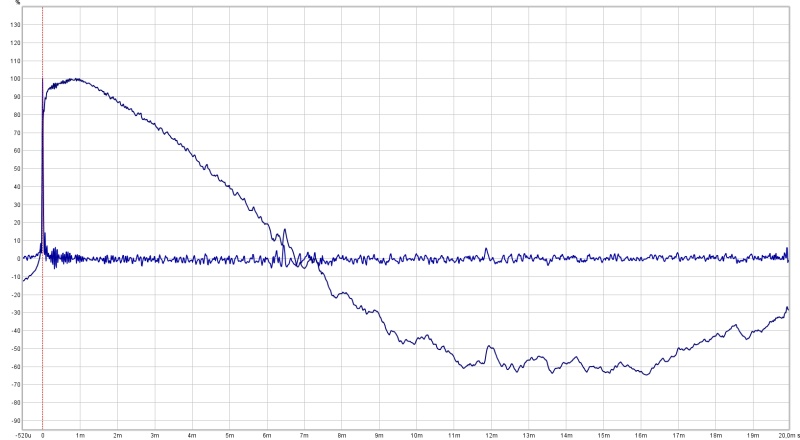
And the FR as seen in a wavelet:

The results follow minimum phase for the most part of the FR spectrum, except at high frequency. To have it follow minimum phase on the upper part of the spectrum I'd have to include the physical roll off in my DRC-FIR template (right now DRC-FIR assumes flat correction out to 20 kHz, as it is set to correct from 20 Hz to 20 kHz). I might try that change later on. (it still has output up high, though much more uneven utill about 21 kHz)
Here's some predictions for the Stereo result:
The predicted IR at the sweet spot:
And the FR as seen in a wavelet:
The results follow minimum phase for the most part of the FR spectrum, except at high frequency. To have it follow minimum phase on the upper part of the spectrum I'd have to include the physical roll off in my DRC-FIR template (right now DRC-FIR assumes flat correction out to 20 kHz, as it is set to correct from 20 Hz to 20 kHz). I might try that change later on. (it still has output up high, though much more uneven utill about 21 kHz)
Attachments
Is there a really cheap (2 usd?) driver to use for a concept try-out?
//
With arrays I'd be careful picking 'just a cheap driver' in general. I have said it before, you can't fix a ringing driver within an array. You'd just get it back on steroids instead. Its warts and faults exaggerated.
I assume you'd like to try that diffraction slot with an array of small drivers?
Hmm not really. Just want to build something for my summer house and also learn a few things while having some fu
//
Have you seen X's mini-karlsonators?
That's a cheap fun build for a summer house.
Another day, more measurements...
I had pointed out 3 different suspects for the weird behaviour in my DRC-FIR correction file.
- The new accessories placed in the room
- Baffle might have come a bit loose
- Different amp with different behaviour
I forgot all about option number 4, the new long optical SP/Dif connection. Today I switched back to my short optical "cable". Also needed to hook up the long RCA cables again and move the DAC back to its former position, close to the PC.
Bingo, new measurements and new correction file are free from any weird artefacts.
I ran multiple measurements this time, one in the exact sweet spot and 8.5 and 16 cm in either direction.
Meaning a left center, a left with the mic moved 8.5 cm to the left side (ear position) and one 16 cm more to the left.
Same for the right side, this time moving to the right. It will take me quite a while to go trough all files again to complete it, but the basic results look fine. All in all I measured at least 3 times in each position of the microphone.
I made an (vector) average from all 9 measurements per side.
I had to work in between traffic, messed up about half way and needed to do it all over again which was no fun. I was in a hurry as time was limited, and being in a hurry usually means forgetting the basics and having to redo all of it .
.
Anyway, I listened to my previous correction file (the one based on a single position, with still the slight flaw in the right channel correction). I really enjoyed what I heard, I think I may have found the recipe I wanted, at least as far as targets and post EQ goes.
Lets find out (in a week or two) if an average at the sweet spot can do even better than this. The RAW measurements look very close to each other on each side between the center, 8.5 cm and 16 cm spots. Only tiny differences between them in a 6 cycle window.
Lets see a graph of that:
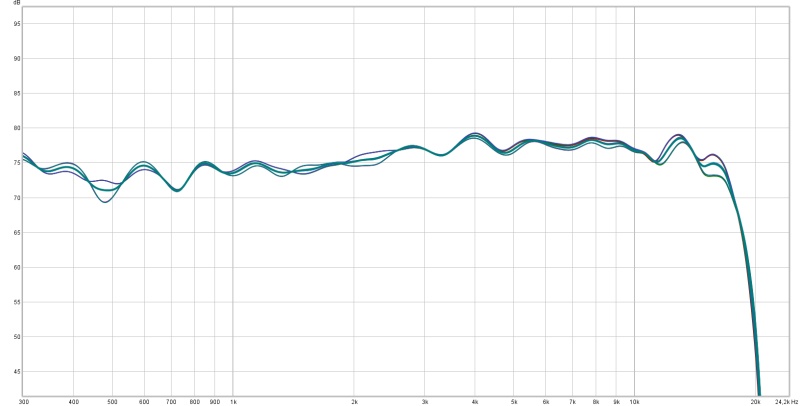
What you see here are the RAW measurements of the left channel. There are 9 measurements in total and the fat green line is the REW vector average.
So 3 measurements right at the microphone sweet spot, 3 measurements 8.5 cm more to the left and 3 more taken 16 cm to the left. The bottom end is even closer together, the biggest deviation overall is at 480 Hz and is 3.1 dB (over a very small area).
So no shocking differences if you move the mic (or your ear) a little to the left or right. This is what you get if the first reflections are reduced far enough. And, obviously, if the driver itself is well behaved. It proves the point that it isn't a big problem to correct for a single microphone position, as long as the room does not mess things up.
I might as well show the right side too:
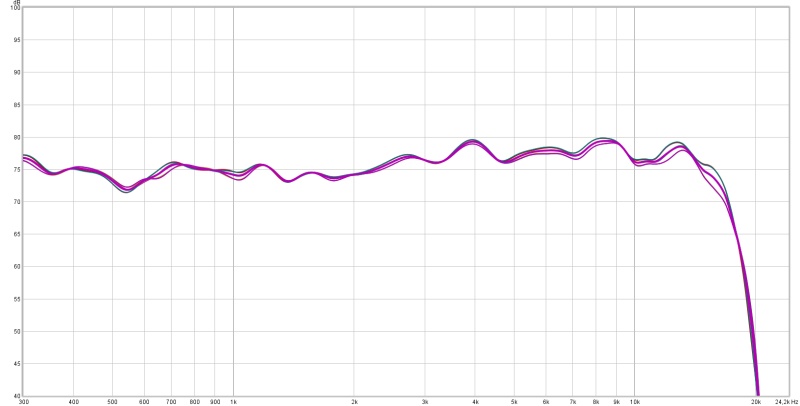
(even less deviation there)
I had pointed out 3 different suspects for the weird behaviour in my DRC-FIR correction file.
- The new accessories placed in the room
- Baffle might have come a bit loose
- Different amp with different behaviour
I forgot all about option number 4, the new long optical SP/Dif connection. Today I switched back to my short optical "cable". Also needed to hook up the long RCA cables again and move the DAC back to its former position, close to the PC.
Bingo, new measurements and new correction file are free from any weird artefacts.
I ran multiple measurements this time, one in the exact sweet spot and 8.5 and 16 cm in either direction.
Meaning a left center, a left with the mic moved 8.5 cm to the left side (ear position) and one 16 cm more to the left.
Same for the right side, this time moving to the right. It will take me quite a while to go trough all files again to complete it, but the basic results look fine. All in all I measured at least 3 times in each position of the microphone.
I made an (vector) average from all 9 measurements per side.
I had to work in between traffic, messed up about half way and needed to do it all over again which was no fun. I was in a hurry as time was limited, and being in a hurry usually means forgetting the basics and having to redo all of it
Anyway, I listened to my previous correction file (the one based on a single position, with still the slight flaw in the right channel correction). I really enjoyed what I heard, I think I may have found the recipe I wanted, at least as far as targets and post EQ goes.
Lets find out (in a week or two) if an average at the sweet spot can do even better than this. The RAW measurements look very close to each other on each side between the center, 8.5 cm and 16 cm spots. Only tiny differences between them in a 6 cycle window.
Lets see a graph of that:
What you see here are the RAW measurements of the left channel. There are 9 measurements in total and the fat green line is the REW vector average.
So 3 measurements right at the microphone sweet spot, 3 measurements 8.5 cm more to the left and 3 more taken 16 cm to the left. The bottom end is even closer together, the biggest deviation overall is at 480 Hz and is 3.1 dB (over a very small area).
So no shocking differences if you move the mic (or your ear) a little to the left or right. This is what you get if the first reflections are reduced far enough. And, obviously, if the driver itself is well behaved. It proves the point that it isn't a big problem to correct for a single microphone position, as long as the room does not mess things up.
I might as well show the right side too:
(even less deviation there)
Attachments
Last edited:
Yes it did, as that was the only variable changed. I have not re-tightened the baffle and the new accessory is still in place.
I can see the difference in the raw measurement between them if I don't smooth and just look at the phase (gated 2 ms). The wiggle or phase wrap DRC was trying to correct for is gone now. It was present in all 3 prior measurements of the right channel, though they weren't exactly alike.
I don't want to speculate on the optical, but the move back to a shorter one was also rushed by the inability to play high res material in it's native sample rate (up to 24/96). With the short cable I get flawless behaviour up to 96 kHz, the long run only managed 48 kHz.
I seem to recall testing that with my 10 M optical cable (which did fine) but never checked the newly acquired 15 M cable I routed under the floor.
I only went that route because I thought I had troubles with the long RCA cables. That trouble wasn't cable related, it was caused by the amplifier. I switched RCA inputs, 2 relays and a resistor as there was a problem with the schematics of the amplifier.
Koldby helped me correct that error in the DC protection and it has played cleanly ever since.
So now I'm back to using what I have used for the last 3-4 years cable wise.
Long optical runs may be fine, if you get the right cable. This one was POM based, not actual glass fibre.
The short one is POM based too, though, but that does not seem to be an issue over shorter runs.
I can see the difference in the raw measurement between them if I don't smooth and just look at the phase (gated 2 ms). The wiggle or phase wrap DRC was trying to correct for is gone now. It was present in all 3 prior measurements of the right channel, though they weren't exactly alike.
I don't want to speculate on the optical, but the move back to a shorter one was also rushed by the inability to play high res material in it's native sample rate (up to 24/96). With the short cable I get flawless behaviour up to 96 kHz, the long run only managed 48 kHz.
I seem to recall testing that with my 10 M optical cable (which did fine) but never checked the newly acquired 15 M cable I routed under the floor.
I only went that route because I thought I had troubles with the long RCA cables. That trouble wasn't cable related, it was caused by the amplifier. I switched RCA inputs, 2 relays and a resistor as there was a problem with the schematics of the amplifier.
Koldby helped me correct that error in the DC protection and it has played cleanly ever since.
So now I'm back to using what I have used for the last 3-4 years cable wise.
Long optical runs may be fine, if you get the right cable. This one was POM based, not actual glass fibre.
The short one is POM based too, though, but that does not seem to be an issue over shorter runs.
Last edited:
Upon further comparison between the raw measurements, the one made with the long optical cable showed a dip 15 dB deeper than the measurement made with the short cable.
Only clearly visible in an unsmoothed gated measurement. As a result it probably triggered the dip limiting within DRC-FIR, leading to the artefact.
Only clearly visible in an unsmoothed gated measurement. As a result it probably triggered the dip limiting within DRC-FIR, leading to the artefact.
I mentioned my troubles with the long optical cable at work, where one of my 'students' said: I have a cable you can try, it's old but should still be functional.
I tried it (with long RCA) and it runs 24/96 without a glitch while being 10 meter long. So my troubles were caused either by a bad cable or bad routing. I took great care while routing the cable though. No weird bends anywhere...
No way to know for sure, but I think this might be an actual glass fibre cable I borrowed. The way it emits (bright) light from one end as soon as the other end is even pointed at a window...
For now I'm happy with the short run of SP/Dif - long RCA. Even though part of me wants to replace that short cable with an actual glass fibre based optical cable of similar length. If I knew where to get a decent one without breaking the bank.
I might try and acquire this cable I tested today for future options.
I tried it (with long RCA) and it runs 24/96 without a glitch while being 10 meter long. So my troubles were caused either by a bad cable or bad routing. I took great care while routing the cable though. No weird bends anywhere...
No way to know for sure, but I think this might be an actual glass fibre cable I borrowed. The way it emits (bright) light from one end as soon as the other end is even pointed at a window...
For now I'm happy with the short run of SP/Dif - long RCA. Even though part of me wants to replace that short cable with an actual glass fibre based optical cable of similar length. If I knew where to get a decent one without breaking the bank.
I might try and acquire this cable I tested today for future options.
Have you seen X's mini-karlsonators?
That's a cheap fun build for a summer house.
Thanks - went this way after all...
My FR10HM corner-ceiling-roof-array
//
- Home
- Loudspeakers
- Full Range
- The making of: The Two Towers (a 25 driver Full Range line array)

